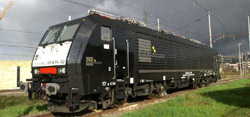Locomotives passed homologation

From Antwerp to Genoa: The Siemens Eurosprinter ES64F4 locomotive passed homologation for Belgium and is ready for revenue service in six European countries: Germany, Italy, the Netherlands, Austria, Switzerland – and now also in Belgium.<br>
The HLE 18 multi-system locomotive from the Siemens Eurosprinter family has just received homologation for Belgium. The HLE 18 is manufactured at the Siemens plant in Munich-Allach for the state-owned railway operator “Société Nationale des Chemins de Fer Belges/ Nationale Maatschappij der Belgische Spoorwegen” (SNCB/NMBS). Delivery of the initial batch of vehicles has already commenced. 25 units have been handed over to the customer to date; the remaining 95 are scheduled for delivery by October 2012. SNCB ordered the first 60 locomotives in 2006 and another 60 at InnoTrans, the International Trade Fair for Transport Technology, in 2008.
All 120 locomotives are designed for passenger transportation. 96 units are of type HLE 18 and the last 24 will be HLE 19; in contrast to the HLE 18, the latter will be equipped with automatic central buffer coupling on one side. The new locomotives will partly substitute existing rolling stock or be used to create additional capacity in the Belgian railway network. Siemens is planning to apply for homologation for the rail networks of the neighboring countries France and Luxembourg in order to ensure that the units can also be used for cross-border service. In addition, approvals for the railway lines to Maastricht, Roosendaal and Aachen (Aix-la-Chapelle) will be sought.
The Eurosprinters HLE 18 and HLE 19 are designed as four-axle multi-system locomotives. They can operate at a maximum speed of 200 kilometers per hour and develop a rating of 6,000 kilowatt. Each locomotive produces a starting tractive effort of 300 kilo newton and weighs 88 tons.
The Eurosprinter ES64F4 has also passed homologation for Belgium. This means that the VL variant of the Siemens ES64F4 locomotive can now operate in as many as six countries: Germany, Italy, the Netherlands, Austria, Switzerland – and now also in Belgium. The locomotives are prepared for revenue service in the entire freight corridor that stretches from the so-called ARA ports (Antwerp, Rotterdam and Amsterdam) as far as Genoa. The variants available so far were not able to provide a link to Antwerp.
The Siemens Rail Systems Division (with headquarters in Berlin) is a leading international provider of rail vehicles and related services. Its portfolio comprises the entire spectrum of rolling stock – including railway trains, metros and locomotives and even streetcars and light rail systems. To this end, the Division smoothly combines its expertise in the fields of mass transit, mainline and logistics transportation in order to offer comprehensive know how for eco-friendly, efficient and reliable rail vehicles that are already in revenue service in more than 40 countries worldwide. Within the Siemens Rail Systems Division the Locomotives and Components unit (Munich-Allach) is responsible for the international business with locomotives and related components. Its portfolio comprises multi-system locomotives, fast running locomotives, traction systems, undercarriages, onboard power supply systems and also electrical and mechanical components.
Editor
Stefan Kirsch
+49 30 386 22377
stefan.sk.kirsch@siemens.com
Media Contact
More Information:
http://www.siemens.com/rail-systemsAll latest news from the category: Corporate News
Newest articles

NASA: Mystery of life’s handedness deepens
The mystery of why life uses molecules with specific orientations has deepened with a NASA-funded discovery that RNA — a key molecule thought to have potentially held the instructions for…

What are the effects of historic lithium mining on water quality?
Study reveals low levels of common contaminants but high levels of other elements in waters associated with an abandoned lithium mine. Lithium ore and mining waste from a historic lithium…

Quantum-inspired design boosts efficiency of heat-to-electricity conversion
Rice engineers take unconventional route to improving thermophotovoltaic systems. Researchers at Rice University have found a new way to improve a key element of thermophotovoltaic (TPV) systems, which convert heat…



